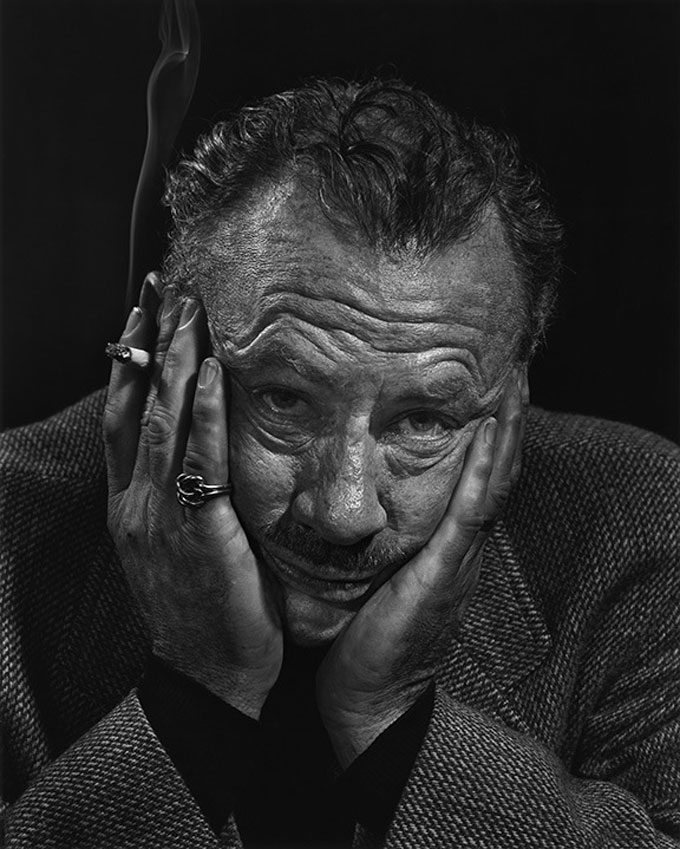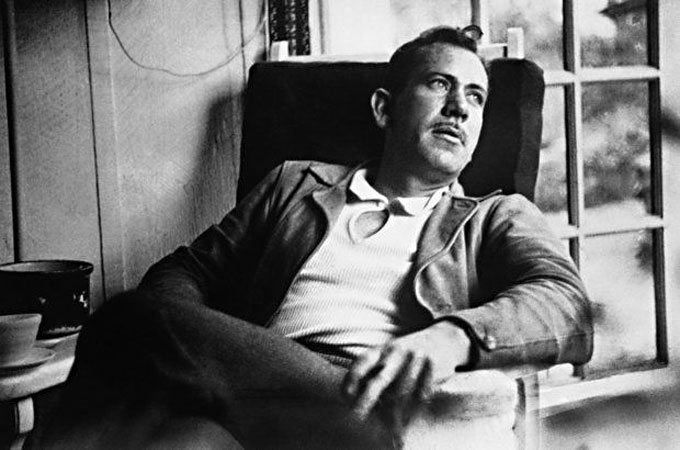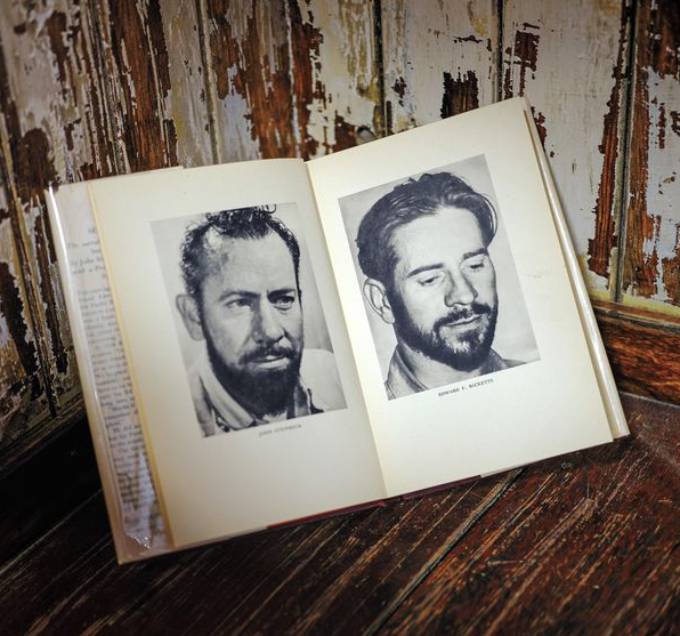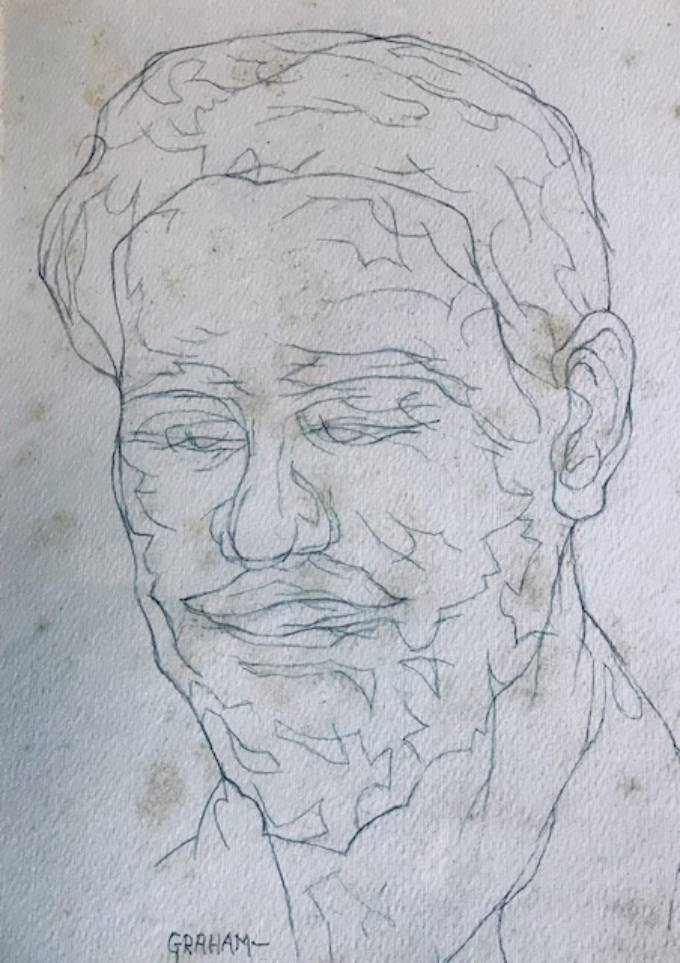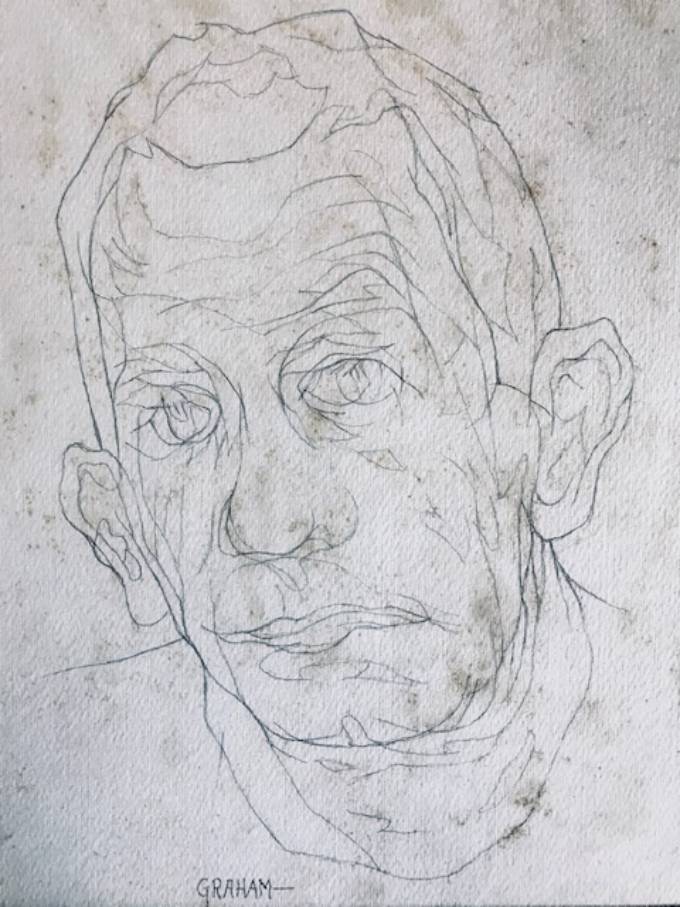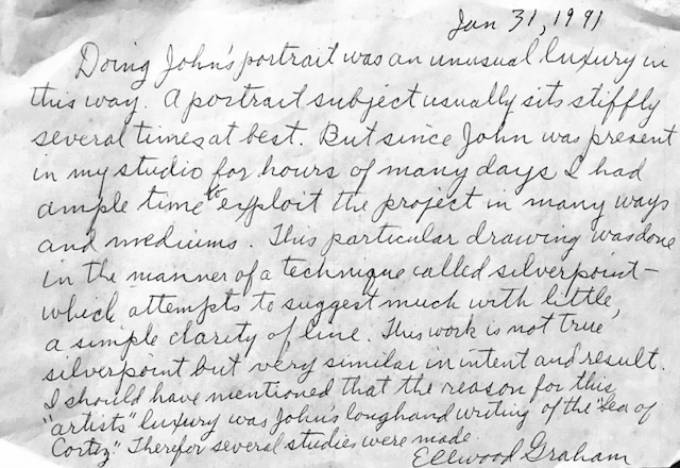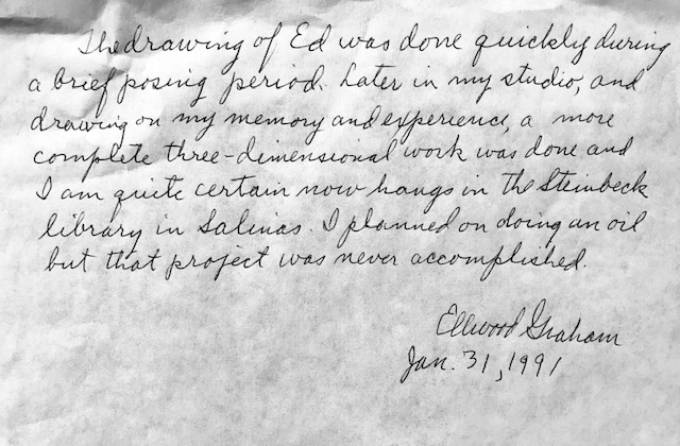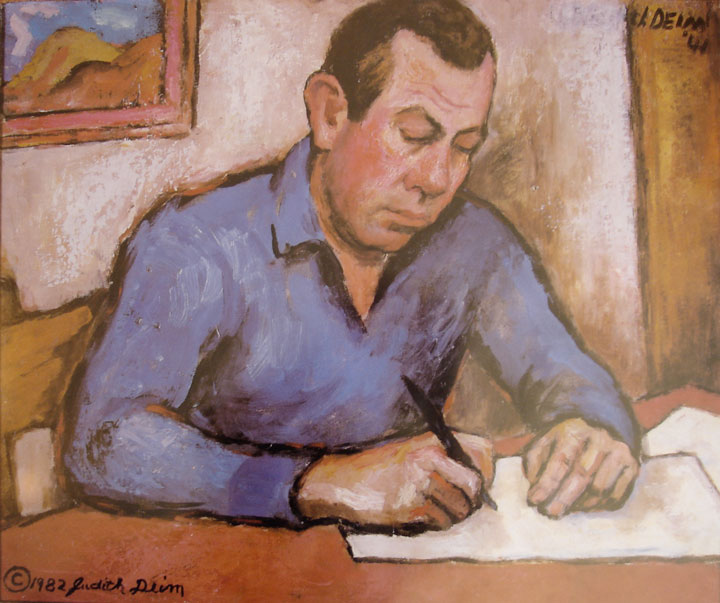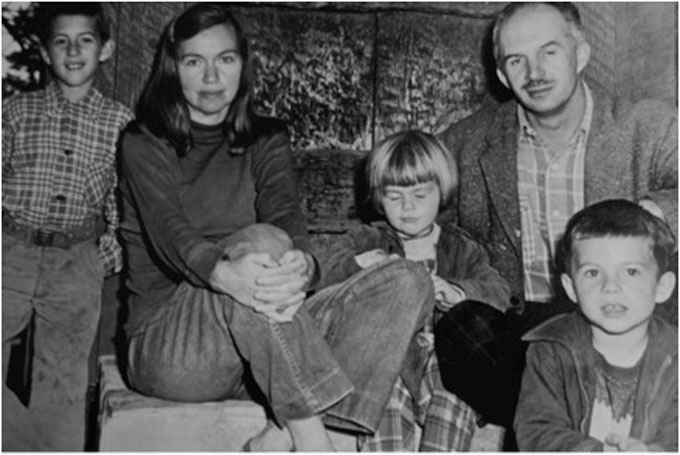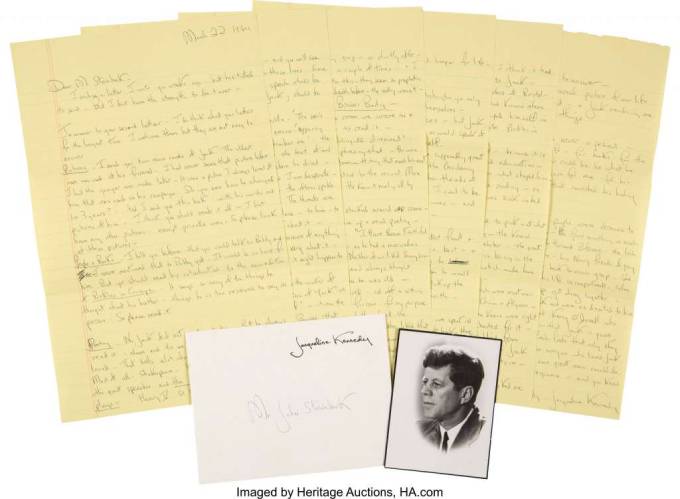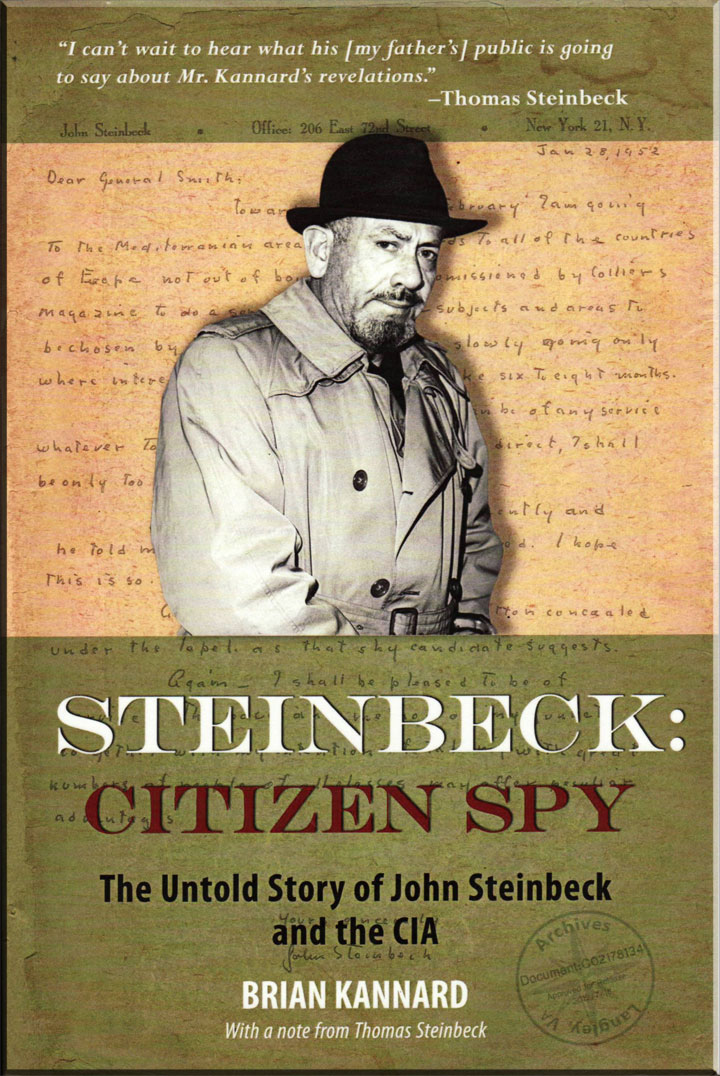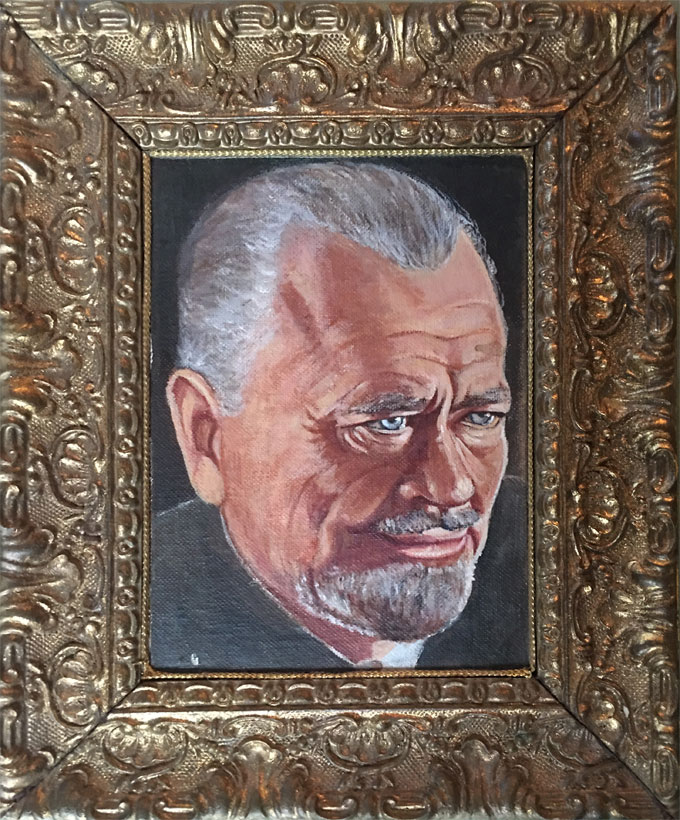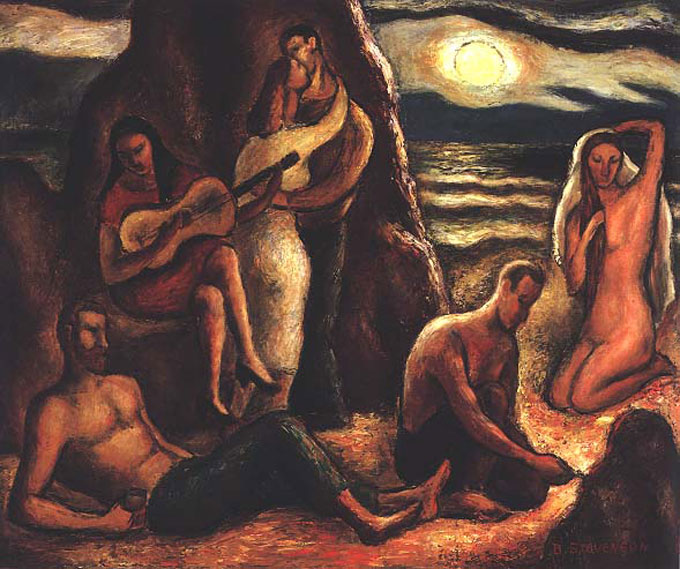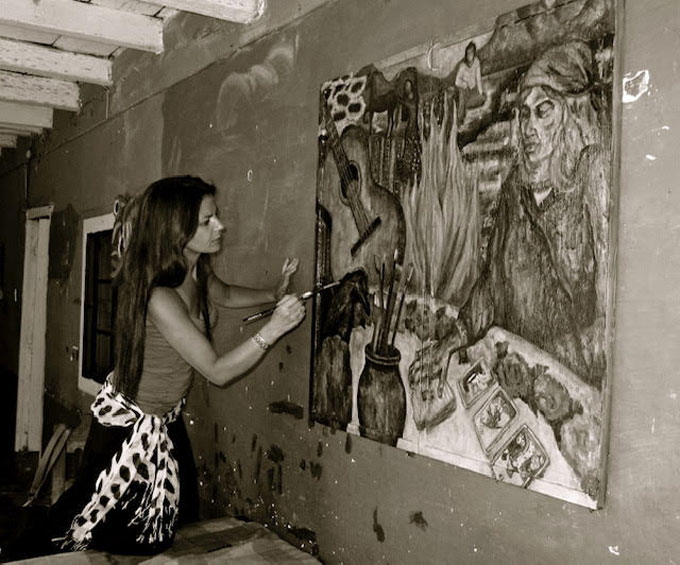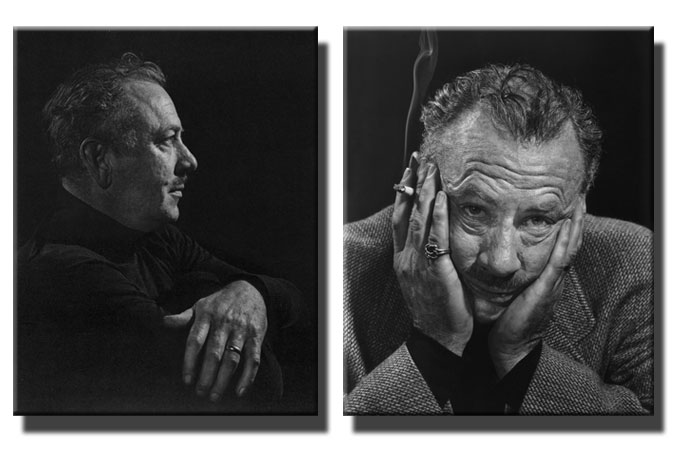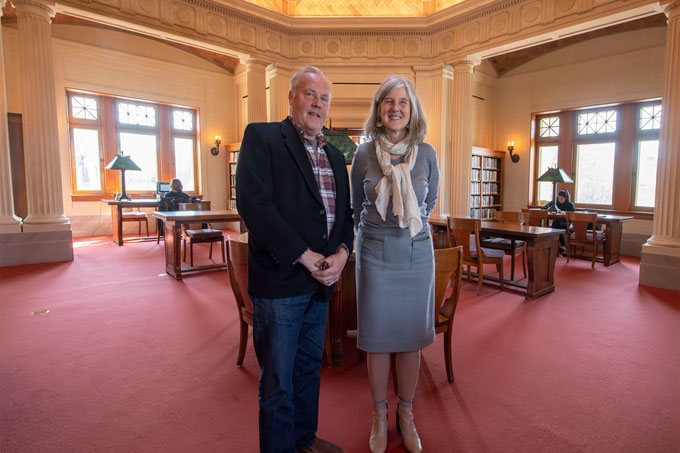Hard news from three different sources suggests the year ahead will be a busy one for followers, fans, heirs, and collectors of John Steinbeck. Steinbeck at Stanford is the subject of a special January 30 library event at Stanford University (sold-out as of this writing) that includes a lecture by Stanford professor Gavin Jones and an exhibit of items from Stanford’s substantial collection of Steinbeck editions, manuscripts, and memorabilia. Hard on the heels of October’s sale of manuscripts and personal possessions from the estate of Steinbeck’s widow Elaine, by an auction house in San Francisco, New Jersey’s Curated Estates auction service has announced the sale of items—including Steinbeck’s baby hair and confirmation certificate—timed to end on February 27, the author’s birthday. As reported by the Hollywood Reporter, attorneys for the widow of Steinbeck’s son Thom are taking their case for reassigning the movie rights to Steinbeck’s books all the way to the Supreme Court, assuming the high court finds time for issues beyond impeachment and tax returns in the busy year ahead.
Hard News Forecasts Busy Year Ahead for Followers, Fans of John Steinbeck
Fall 2019 Steinbeck Review Reconsiders John Steinbeck
The Fall 2019 issue of the journal Steinbeck Review, a biannual publication of Penn State Press in cooperation with the Martha Heasley Cox Center for Steinbeck Studies at San Jose State University, is now available online and in print. Contents include essays on aspects of John Steinbeck’s life and work as a proto-ecologist and internationalist viewed from a contemporary perspective; the publishing history of Steinbeck’s books in the former Iron Curtain countries of Eastern Europe; and the challenges of teaching Steinbeck to students who may be better versed in the #MeToo movement than the progressive labor movement that preoccupied Steinbeck’s interest and writing in the 1930s. Also included in the Fall 2019 issue are book reviews, announcements, and a summary of Steinbeck news since the summer.
Sketches of John Steinbeck and Ed Ricketts Resurface in Carmel, California Collection
Numerous artists drew, painted, or photographed John Steinbeck, but artistic images of his friend Ed Ricketts are relatively rare. This made the chance discovery of a drawing of Ricketts by Ellwood Graham—in a Carmel, California art collection that also includes Graham’s sketch of Steinbeck—especially exciting. Both drawings are discolored and have acid burn, but Graham’s lines are vivid and the impression in both, even before restoration, remains strong.
In 1991 Graham penned his remembrance of doing the two drawings (shown here) around 1940-41, and in 1995 they were included in a Monterey Museum of Art exhibition, curated by Richard Gadd and called “Monterey Life: The Steinbeck Years.” Ironically, when I came across the pair on my first visit to a Carmel collector’s home several months ago I was writing The Willow Grave, a screenplay on Graham and his wife Judith Deim. Ricketts and Steinbeck are significant characters in the story.
“Doing John’s Portrait Was an Unusual Luxury” for Artist
Graham’s recollection of sketching Steinbeck was still fresh when he wrote this note:
Doing John’s portrait was an unusual luxury in this way. A portrait subject usually sits stiffly several times at best. But since John was present in my studio for hours of many days, I had ample time to exploit the project in many ways and mediums. This particular drawing was done in the manner of a technique called silverpoint – which attempts to suggest much with little, a simple clarity of line. This work is not true silverpoint but very similar in intent and result. I should have mentioned that the reason for this “artists” luxury was John’s longhand writing of “The Sea of Cortez.” Therefor several studies were made.
Equally strong was Graham’s memory of sketching Ricketts:
The drawing of Ed was done quickly during a brief posing period. Later in my studio, and drawing on my memory and experience, a more complete three-dimensional work was done and I am quite certain hangs in the Steinbeck library in Salinas. I planned on doing an oil but that project was never accomplished.
Ellwood Graham and Judith Deim—then going by her given name of Barbara Stevenson—were artists from St. Louis, Missouri, who made their way to California on Route 66 during the Dust Bowl days of the Great Depression. By chance in Los Angeles they met Gordon Grant, the California artist who was creating murals under the auspices of the Federal Art Project, and he hired them. They were working on the mural in the Ventura, California post office when—again a chance meeting—they met Steinbeck and Ricketts, who were passing through on their way to Mexico. Before parting, Ricketts and Steinbeck invited the young artists to visit Monterey, which, of course, they eventually did. Deim was to do her own portrait of Steinbeck (shown here). It is in the collection of the Martha Heasley Cox Center for Steinbeck Studies. Graham also did an oil portrait of the writer, but it was lost and its whereabouts are unknown.
Newlyweds, Deim and Graham (shown with their children in this undated photo) met as students in the School of Fine Arts at Washington University and went on to distinguished careers in California and Mexicao. Deim exhibited at the San Francisco Museum of Art, the Palace of the Legion of Honor, and the Patzcuaro Museum (she spent the last years of her life in Mexico’s Michoacan). Among many honors, she was the first artist given a solo exhibition at the Carmel Art Association, in 1946. Graham has work in the Whitney Museum, the Los Angeles County Museum of Art, the De Young Museum, and the Monterey Museum of Art. Among dozens of exhibits and solos, he had work in the 1939 Golden Gate International Exhibition in San Francisco. Deim spent her last years in Mexico. Graham died in Oregon.
An art dealer in Los Angeles who specializes in early modernism told me he knew Graham had a strong sense of his worth as an artist, “because when I find his old paintings, they usually have a pretty high price—for the time—on the reverse side.” Steinbeck and Ricketts believed in Graham and Deim’s talent; Steinbeck, for instance, felt easy enough in their presence to write while they painted him. Luck brought Graham and Deim to the attention of Gordon Grant in Los Angeles and Ricketts and Steinbeck at the Ventura post office. I, too, was fortunate to happen upon Ellwood Graham’s drawings in that Carmel collection.
Ellwood Graham’s recently rediscovered sketches of John Steinbeck and Ed Ricketts courtesy of private collector in Carmel, California.
John Steinbeck Sale Another Reminder of Missing History
Like the recent donation of the S.J. Neighbors collection of John Steinbeck papers to Stanford University, the upcoming sale of John Steinbeck memorabilia by Heritage Auction House in San Francisco serves as a reminder that much remains to be learned about the author’s life and work—and that access to documents is key to discovery. Among the 36 items on offer, spanning 100 years of Steinbeck family history, are the walnut box Steinbeck’s grandfather gave his grandmother, an early manuscript of his novel Tortilla Flat, and the journal he kept when he was writing The Wayward Bus. Also included are letters from President John Kennedy and First Lady Jacqueline Kennedy, the latter in response to questions posed to her by Steinbeck for the biography she asked him to write following her husband’s assassination in 1963. “I enclose a letter I wrote you weeks ago – but hesitated to send. But I don’t have the strength to do it over. In answer to your second letter – I do think about your letters for the longest time. I welcome them but they are not easy to answer,” wrote Mrs. Kennedy in 1964.
Christopher Dickey Asks: Was John Steinbeck a CIA Informant in Paris in 1954?
Was John Steinbeck acting as a CIA informant in Paris the summer he wrote the satirical short story for Le Figaro, published in English for the first time in the current issue of The Strand, about a haughty French chef and his hyper-finicky cat? That’s the question raised in a provocative Daily Beast piece by Christopher Dickey, the Daily Beast’s Paris-based world-news editor. Working his way to a firm maybe, Dickey quotes John Steinbeck’s contemporaneous correspondence with his New York agent, Elizabeth Otis, and Thom Steinbeck’s eye witness account—first cited by Brian Kannard in his 2013 book Steinbeck: Citizen Spy—of daily visits to the Steinbeck’s residence at 1 Avenue de Marigny by a man from the U.S. embassy with an attaché case. The son of a famous father, like Thom Steinbeck, Christopher Dickey is a frequent contributor to Foreign Affairs, Vanity Fair, The New York Times, MSNBC, CNN, France 24, BBC TV, and Al Jazeera.
New Light on John Steinbeck at Stanford’s Green Library
A trove of documents donated to Stanford University—the S.J. Neighbors collection of John Steinbeck papers, 1859-1999—adds dramatic detail to a literary life story that started in 19th century Germany and Palestine and became synonymous with 20th century California and America. Totaling 256 items, the acquisition is the largest since 1999, when Wells Fargo funded the addition of a major collection of Steinbeck material to the holdings of the newly renovated Green Library, which first opened in 1919, the year Steinbeck enrolled at Stanford as a freshman. The new collection includes correspondence to and from John Steinbeck, notebooks kept by his American grandmother, Almira Steinbeck, and lecture notes written by her earnest, German-born husband about their missionary work in Palestine and the attack on their compound in Jaffa that sent them packing for the United States, just in time for the outbreak of the Civil War. According to Rebecca Wingfield, curator of British and American literature, the addition of the S.J. Neighbors collection makes the Stanford University Library the most important resource anywhere for research on Steinbeck’s roots. Her colleague Ben Stone, curator of American and British history, notes that the school’s commitment to Steinbeck includes access to the collection by regular readers of the restless American writer who never got around to telling his grandparents’ back story and disappointed his family by leaving Stanford without a degree.
Painted 50 Years Ago, Lost Portrait Comes to Light
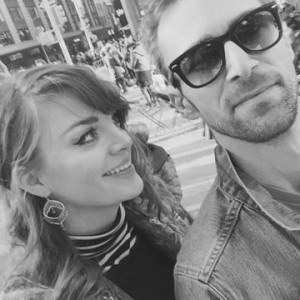 The lucky purchase by a young couple in Austin, Texas—of a lost portrait of John Steinbeck painted by an admirer 50 years ago—presents intriguing questions about the California author’s connection to Texas, the state he celebrated in Travels with Charley because, he said, his wife Elaine grew up there. Anthony Verdecanna, a specialist in mid-20th century furniture, and his wife Whitney, a musician, came across the elegantly framed find recently at an estate sale near Austin. The inscriptions on the back—“To Elaine Steinbeck” and “Virginia Boyd in Thailand 1969”—piqued their curiosity about its provenance. Following the trail of “Jenny Boyd,” the person who signed the work, they learned that the Virginia in the inscription was most likely the artist’s mother, Virginia Hawkins Boyd Connally, a pioneering physician in Abilene and the widow of Ed Connally, chairman of the Texas Democratic Party during the heyday of Lyndon and Lady Bird Johnson. An eye-ear-nose-and-throat specialist whose first husband
The lucky purchase by a young couple in Austin, Texas—of a lost portrait of John Steinbeck painted by an admirer 50 years ago—presents intriguing questions about the California author’s connection to Texas, the state he celebrated in Travels with Charley because, he said, his wife Elaine grew up there. Anthony Verdecanna, a specialist in mid-20th century furniture, and his wife Whitney, a musician, came across the elegantly framed find recently at an estate sale near Austin. The inscriptions on the back—“To Elaine Steinbeck” and “Virginia Boyd in Thailand 1969”—piqued their curiosity about its provenance. Following the trail of “Jenny Boyd,” the person who signed the work, they learned that the Virginia in the inscription was most likely the artist’s mother, Virginia Hawkins Boyd Connally, a pioneering physician in Abilene and the widow of Ed Connally, chairman of the Texas Democratic Party during the heyday of Lyndon and Lady Bird Johnson. An eye-ear-nose-and-throat specialist whose first husband 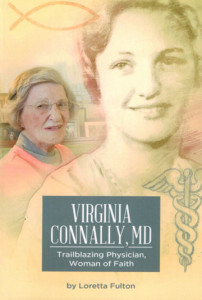 was named Fred Boyd, Dr. Connally was born in 1912 and died on March 31, 2019, leaving her daughter Genna Boyd Davis, an art education major in the 1960s, as her sole immediate survivor. Like a story by Steinbeck, the heroic narrative of Virginia Connally’s life presents multiple possibilities. Did she and Ed meet John and Elaine in Texas through the Johnsons, with whom the Steinbecks were friendly? Or was the writer’s generous portrait of Texas in the pages of Travels with Charley enough to win her affection—and the tribute of a devoted daughter’s painting, lost for 50 years until its discovery by yet another power couple from Elaine Steinbeck’s home state?
was named Fred Boyd, Dr. Connally was born in 1912 and died on March 31, 2019, leaving her daughter Genna Boyd Davis, an art education major in the 1960s, as her sole immediate survivor. Like a story by Steinbeck, the heroic narrative of Virginia Connally’s life presents multiple possibilities. Did she and Ed meet John and Elaine in Texas through the Johnsons, with whom the Steinbecks were friendly? Or was the writer’s generous portrait of Texas in the pages of Travels with Charley enough to win her affection—and the tribute of a devoted daughter’s painting, lost for 50 years until its discovery by yet another power couple from Elaine Steinbeck’s home state?
Artist’s Letter Recalls 1930s Life with John Steinbeck
Seventeen or 18 years ago, maybe longer, the artist Judith Deim faxed me a long handwritten letter from near Lake (or Lago) Pátzcuaro in the Mexican state of Michoacán. It was a history of what she could remember, at around age 90, of her time in Monterey, California in the 1930s and beyond, the years of John Steinbeck and Ed Ricketts and so many others. She told me deep into the missive (in no uncertain terms, which was Judith’s way), “None of this group are living now, so you are lucky to get this story.” I wouldn’t argue that for a second.
Judith Deim’s Eye for Steinbeck’s Circle Never Failed
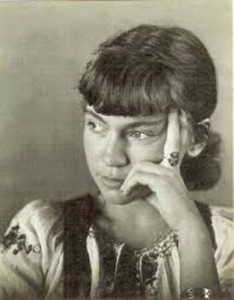 A woman of great talent and immense courage, she traveled Europe and Africa with three children—and sometimes with a band of gypsies—for 16 years. Her marriage splintered and she lost a daughter, a flamenco dancer who drowned off the coast of Spain, and her art, called Magic Realism, became dark. Yet she persevered, composing music as well as painting before dying, at the age of 95, in 2006. She was born Barbara Stevenson in 1911 in St. Louis, where her mother taught piano, and during the Depression she traveled Highway 66 with a fellow artist, Ellwood Graham. The pair met up with Steinbeck and Ricketts in Southern California, which led them to settle in Monterey, and Barbara Stevenson became Barbara Graham. The name Judith Deim came later.
A woman of great talent and immense courage, she traveled Europe and Africa with three children—and sometimes with a band of gypsies—for 16 years. Her marriage splintered and she lost a daughter, a flamenco dancer who drowned off the coast of Spain, and her art, called Magic Realism, became dark. Yet she persevered, composing music as well as painting before dying, at the age of 95, in 2006. She was born Barbara Stevenson in 1911 in St. Louis, where her mother taught piano, and during the Depression she traveled Highway 66 with a fellow artist, Ellwood Graham. The pair met up with Steinbeck and Ricketts in Southern California, which led them to settle in Monterey, and Barbara Stevenson became Barbara Graham. The name Judith Deim came later.
In the late 1930s she created the painting, called “Beach Picnic,” shown above. It depicts a group of companions—including a pensive-looking John Steinbeck, a broad-shouldered Ed Ricketts, and Deim herself—under a night sky. She told me once that artists, photographers, and poets used to accompany Steinbeck when (as reflected in this painting) his friends felt he needed protection. Sometimes Charlie Chaplin would drive up from Los Angeles and join them. The portrait of Steinbeck by Judith shown below hangs in the Martha Heasley Cox Center for Steinbeck Studies at San Jose State University. The one she mentions by Ellwood Graham—a nervous yet compelling effort—has been missing for years.
Judith did not pass unnoticed. I and others wrote about her and her work was exhibited, including a solo show at the Carmel Art Association. The film about her by the award-winning director Irena Salina, “Ghost Bird: The Life and Art of Judith Deim,” was voted an audience favorite on the Sundance Channel. She had a mystical side, as shown in the transcript of the undated letter she wrote me, reproduced here for the first time. Her spelling and grammar required some touching up and she begins with a mistake—mentioning a mural in Santa Barbara which she may be confusing with one she and Ellwood worked on at the Ventura, California post office under the direction of Gordon Grant. But her perceptions of Steinbeck, Ricketts, and their circle are precise, and her eye, unlike her memory, never failed her.
Judith Deim inspired the story “Judith” in my book Steinbeck: The Untold Stories, as well an almost completed screenplay I’m calling “The Willow Grave.” Then again, she has always been inspirational. Her sons Daniel, a sculptor, and Benje, a guitarist, continue her creative legacy. Granddaughter La Tania is a world-renowned flamenco dancer, and another granddaughter, Tiffany (shown here painting Judith), is an oil painter and muralist who works with disadvantaged kids in inner-city Los Angeles. Tiffany’s art, like that of her grandmother, expresses duende—the quality of inspired passion described by Judith in the letter.
Undated, Unpublished Letter from Judith Diem
Dear Steve—
Enclosed response to you [is] material for your article. We planned to record [the] interview with Vatche Geuvadjelian, a poet and painter, but the recording didn’t work (bad sound), so I dictated [the following for] Vatche, which he could write down far better than myself. I hope it will cover several of the questions [you] sent, improvised [with] little time to do it. Use what you wish.
I was working on a 1400-ft. mural in Santa Barbara with Ellwood Graham. I painted all the faces, sometimes mean, sometimes ugly, once in a while sweet. My work was finished [and] I left, where to? [on] the Monterey Peninsula. I met Virginia and Raymond Scardiglio; we liked each other; they invited me to live with them at their apartment in Carmel. They and 12 others of similar artistic interests were the nucleus of the group who met at Ed Ricketts[‘s] lab on Cannery Row in Monterey. There I met John Steinbeck, Ritchie Lovejoy, a writer; his wife Natalia Kashevarof, a Russian woman from Alaska; Dick and Francis Strong, Ed’s sister; Marjorie and Harold Lloyd; Henry Miller [who] came and went when his work permitted; Toby Street, John’s lawyer; and two or three others, thirteen all together. John Steinbeck and his great friend Ed Ricketts were the natural focus.
Carol Steinbeck made it possible, by working in a Relief office, for [John] to devote his time to writing. She was a wonderful country cook, with jars of preserves in all seasons. She was in rapport with all who came to the lab. She was a very important critic [of] his writing by demanding the best from him and [typing] all [of] his manuscripts.
Ed Ricketts was the ever-gracious host. He did his work, sending marine specimens all over the world. A great marine biologist, in the late hours he would disappear [in]to his lab on the ground floor and work. He loved paintings. I gave him one of an old farmwoman that he always kept above his chair, the only painting in the room.
Sometimes John spoke with me of the Big Sur. Going from the Little Sur country, his theory was [that] they were inhabited by poltergeists who were inimical to people invading the countryside and were the cause of [the] occasional disasters that occurred there.
I spent much time exploring that countryside. Sometimes I ran across the great poet Robinson Jeffers and talked with him about things he loved. His narrative poems were based on the tragic stories of people who lived in those canyons. One time I stayed behind my companions to explore an old cabin. Suddenly I felt all my strength being pulled out of me. I crawled with all my strength to get out of the cabin. I [lay] some time on a fallen tree before I continued on.
On the coast there was another well-known log cabin, run by Lolly and Bill Fassett. All [the] coast people and tourists, artists, [and] workers of the countryside gathered there. There was a bar and restaurant. Anderson Creek had been the old prison camp and had houses from the Second World War. Henry Miller and his good friends Elliott Sandow the sculptor, the Niemans, and Lilac Schatz, a fine painter, were working in these old prison houses.
A woman reporter from the Examiner [of] San Francisco came to interview all of them. They were hospitable, entertained her and showed her their work. [Then] the Sunday paper came out, devoting a whole page to the perverse [goings on and the] use of alcohol and drugs, so misusing their hospitality and their values as artists. The American Legion club members got together and planned to burn them out. [We] artists got up a petition and went to all the liberals of the community and succeeded in stopping this terrible plan.
Ellwood Graham returned to Monterey. We built [a] redwood house out of lumber we bought at an auction at Big Sur. Ellwood painted a lot of landscapes and had an experience [with] poltergeists on the Big Sur, where his canvases kept being torn from his easel even though there was no wind. He came back in a black rage, battling with the invisible. I told this story to a friend who had special photographic equipment [and] he went and took photos. The photos showed little floating light forms around the farmhouse. This related to what Steinbeck was saying about the canyons in Little Sur.
A trip was planned with two Italian brothers with their schooner to the Sea of Cortez. After much talk and discussion with the brothers they left. The idea behind the trip was for John to be inspired to write a book about the Sea of Cortez. On the trip Ed kept a log [of] everything that happened from day to day.
On their return [there was] much rejoicing, partying [and] storytelling at the lab. After a few days of this drinking and partying John felt it was time to get to work. He said, I have an inspiration. Why don’t you kids paint my portrait and I shall be forced to concentrate and get on with my book? He wanted Ellwood to have money to establish a studio. So we commissioned him to do his portrait, which he would buy whether he liked the result or not. He also wanted me to paint a portrait in any way I wanted. We celebrated his 40[th] birthday. At the time he was very proud of some Western boots he had bought for himself. He was a lot like a big child . . . . None of this group are living now, so you are lucky to get this story.
He did not like Ellwood’s portrait. [It] brought out an expressionist version of an alcoholic, which John was not. He liked my portrait very much but asked me to keep it as a souvenir, then added, “You might need it.” And I did. It was the only portrait of Steinbeck writing at his desk. I showed in on Cannery Row, where I met Steinbeck’s son [Thom]. He bought six accurately reproduced prints of the painting. I said, “I guess you like it.” He answered, “I like it because it expresses Steinbeck’s sinister side. I am having a difficult time surviving while his will waits until I [am] sixty years old to get it.” Right after the portraits [Steinbeck] suggested that he would pay for us to go to Mexico, and he said, “Go to Pátzcuaro and not to where all the tourists go.”
Pátzcuaro: in a Mexican boardinghouse with a beautiful doña. Raining and dark. At 7:00 p.m. a procession of men with torches. Very little, dim electricity, too low to read with. A dark and wild feeling, in the store windows jars of powder, of everything that humans desire: love, sex, babies, money. Only one outsider in town: a mad Englishman going in circles around the plaza without stopping. It was sad that the townspeople threw rocks to keep strangers out. But they did not throw rocks at us because I was very pregnant.
Lots of rain, and more rain. I got bronchitis and went to bed. Then the money that Steinbeck’s lawyer Toby was to send us did not arrive. The boardinghouse owner kept us going, then Ellwood went to the post office under the rain [and] returned cursing like I had never heard him before. The post office man had found the wire, but instead of paying him he had torn it right in front of Ellwood to little shreds. Finally we got paid, all in small coins. After a few days I got better and we took a boat to Janitzio, a small island in Lake Pátzcuaro. We got into the small motorboat with a married couple who still wore their wedding clothes.
By the time we got [to] the middle of the lake, storm clouds came and covered the sky. Then the motor stopped, the rain came thundering down, [and] the boat would not start, so there we sat, me coughing and soaked. In one hour a boat came and towed us to the island. A fish café [that] offered shelter played old songs [and] had an old Victrola. We were freezing so we danced, danced, and danced. I danced with [the doña] and Ellwood. I asked for a baño [and] her daughter took me to [a] totally flooded room. I made do [and] we stayed the night and [the] next day [took] a larger boat to Pátzcuaro. I had back pains [which] became serious, so we went to a doctor. He was in [the] midst of an operation but said that I had a serious infection that needed to be surgically cleaned. He finished amputating a leg in this rather dirty room [while] the nurse stripped me down and scrubbed me all over with this rather stiff brush. [The] next day [when] I was taken to be operated [on] the next operating table was full of guts and blood, [so] I bade this world goodbye. He put an old gas mask on my face and put me to sleep, 7 months pregnant. [The] next day he moved me out to the back of the station wagon because he had no room in the hospital of only one room.
Next stop Laredo, to pick up [a] money order. I stayed in the back of the car [while] Ellwood went to the post office. For an endless period of time he did not come back. Finally I struggled to get up and managed to go to the post office. He had been sent to the 5[th] floor and [the] postmaster was having him fingerprinted. On seeing me barely able to walk and very pregnant, he softened up and finally gave us the money.
We finally headed out to Monterey, Ca[lifornia]. But Ellwood started to run a high fever in the middle of Texas. We got ourselves in[to] a boardinghouse and contacted a doctor. First an old doctor [who] diagnosed malaria wanted to give him quinine, but the young assistant [who] wanted tests made in El Paso registered Ellwood into a hospital, very sick. [The] tests came back negative for malaria, but the old doctor insisted [on giving the] cure [for] this symptom. [When] the young doctor refused the older doctor appealed to my female intuition and I said, “Give him quinine.” In a few days he got better, but with big black-circled eyes.
Next [there was] a flood [and] a truck had to pull us out. Finally, [when] we got back with Steinbeck, who was anxious to see us back, [and] he took care of everything, including my delivery. There were celebrations in the lab with John and our friends. Pátzcuaro was inspiring and drew me back [in the] early [19]80s. I have painted a large number of paintings [that] I believe have “duende.”
Judith Deim
[P.S.] With so little time to write this [and] to get it off by Monday, I improvised spontaneously, trying to satisfy several inquiries [by this] subjective approach. If there is anything you would like me to elaborate on send a fax concerning it and I will fax back if possible. J.D.
“Beach Picnic” by Judith Deim courtesy of private collector. Portrait of John Steinbeck by Judith Deim courtesy Martha Heasley Cox Center for Steinbeck Studies.
New Light on John Steinbeck
According to Yousuf Karsh it was Art Buchwald who made the introduction that led to John Steinbeck’s June 15, 1954 sitting in Paris with the 40-something photographer from Ottawa. An amateur film maker who disliked having his photo taken but liked pictures and people with panache, Steinbeck warmed to Karsh, a Boston-trained Canadian immigrant whose black and white portraits of Winston Churchill and other public figures had already made him famous. Karsh’s European elegance and wit won over the author of East of Eden, distracted and depressed by events following the publication of the novel into which he’d folded the story of his mother’s family, the Scotch-Irish Hamilton clan. But it was his father’s family history that connected him to Karsh, an Armenian of Arab descent whose parents escaped Turkey through Syria during the 1914 Armenian genocide that signaled the final end of the Ottoman Empire. A half-century earlier, in the 1850s, Steinbeck’s Prussian-English grandparents made a similar escape following an attack on their missionary compound by Arab marauders in Ottoman-controlled Palestine. The ancestral sagas of both men included flight from the Holy Land, haven in New England, and secular self-reinvention against a background of 19th century marriage, migration, and religious mania. Recent detective work has unearthed new details about Steinbeck’s 19th century roots and 20th century connections, including the true story of his family’s religious conversion and the facts behind the fictions regarding his time at Stanford. Starting in 2019, these and other topics will be explored in a new series of essay posts at Steinbeck Now that put new light on John Steinbeck, like a portrait by Yousuf Karsh.
Sag Harbor Library Returns John Steinbeck’s Love
When John Steinbeck and his wife Elaine bought a home in Sag Harbor, New York in 1955, the whaling village on the eastern tip of Long Island had the essential ingredients for happiness the controversial writer missed after leaving Pacific Grove, California—water, history, and a casual lifestyle, like Cannery Row, that allowed for anonymity. New England whaling had gone the way of the California sardine industry long before the couple’s arrival, but weekend fishing was still good and a Sag Harbor tradition of hospitality to authors, starting with James Fenimore Cooper, survived. That particular tradition is on display again through December 20, 2018, the 50th anniversary of John Steinbeck’s death, with a commemoration of Steinbeck’s life by Sag Harbor’s John Jermain public library, named after a local hero from Cooper’s time. Activities include films, library talks, and a digital wall of remembrance for residents who knew or saw Steinbeck when he and Elaine were in town. (Catherine Creedon, the library director, is shown with Preservation Long Island award recipient Zach Studenroth in this April 11, 2018 photograph by Michael Heller, courtesy of the Sag Harbor Express.)
